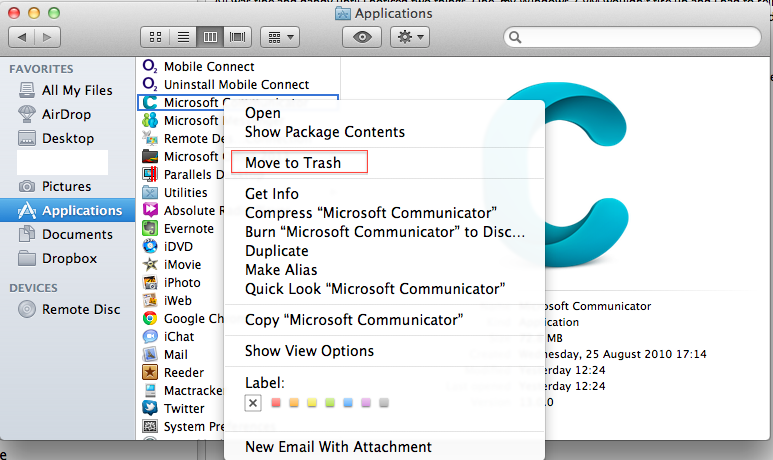Joining Microsoft Messenger is a new business counterpart in Office 2011 for Mac, Microsoft Communicator. Both products offer similar features and interfaces, but each is designed for a different market:
Microsoft Messenger: Uses your Windows Live ID (such as your Hotmail e-mail address) to communicate with contacts using public servers. Requires a Windows Live account to sign in.
Microsoft Communicator: Designed to use fully updated Microsoft Exchange Server 2007 or later to communicate within a closed business environment. The corporate contact list has been moved from Messenger to Communicator. Communicator supports Microsoft Exchange Global Address List (GAL).
Microsoft Office Communicator 2007
Microsoft Communicator 2011 is used by Microsoft Office to allow instant messaging, audio chatting and video/web conferencing. Microsoft Communicator 2011 is essentially a Microsoft branded instant messaging client designed for businesses, and is a progression from Microsoft Messenger but it offers far more power and features. Microsoft Communicator for Mac 2011 Microsoft Messenger for Mac 2011 As part of Office 2011, Microsoft has released new versions of its home and corporate instant messaging (IM) applications. Update Office from the Mac App Store. If you downloaded Office from the Mac App Store, and have automatic updates turned on, your apps will update automatically. But you can also manually download the updates: Open the Mac App Store from your Dock or Finder. Start quickly with the most recent versions of Word, Excel, PowerPoint, Outlook, OneNote and OneDrive —combining the familiarity of Office and the unique Mac features you love. Work online or offline, on your own or with others in real time—whatever works for what you’re doing. Microsoft Office for Mac 2011 is a version of the Microsoft Officeproductivity suite for Mac OS X. It is the successor to Microsoft Office 2008 for Mac and is comparable to Office 2010 for Windows. Office 2011 was followed by Microsoft Office 2016 for Mac released on September 22, 2015, requiring a Mac with an x64 Intel processor and OS X Yosemite or later.

Microsoft For Mac 2011
Both Messenger and Communicator offer a variety of ways to communicate, collaborate, and share work. Logging in to either product involves a simple username and password sign-on.
Managing contacts in Microsoft Messenger and Communicator

The Contact List displays when you open Messenger or Communicator. Starting at the top, you have access to a lot of tools:
Add: Displays the Add a Contact dialog.
Send: Click the Send button and then choose a contact from the pop-up menu to open a text instant message conversation window.
Call: This feature requires speakers and microphones on both ends of the call. Communicator supports PC to phone dialing.
Video: This feature requires video camera, speaker, and microphones on both ends of the call.
Send File: Click and then choose a contact from the pop-up menu. You see a file Open sheet, which you can use to choose a file or photo to send to the selected contact.
Page: Click and then choose a contact from the pop-up menu. If you haven’t set up your mobile message preferences, the Preferences dialog opens. Normally, Page displays the Page message input window. Type a text message to be sent to your contact’s cellphone or mobile device.
Mail: Opens your Web browser to view your mail account. Displays how many unread messages you have in your inbox.
Indicating Presence in Messenger and Communicator
The Presence Indicator is a new feature of Office 2011. It has these buttons across the bottom:
Send Mail: Opens a new browser window to a new, blank, pre-addressed e-mail message window.
Send Instant Message: Opens a conversation window and requests the contact to engage in a text chat session.
Voice Call: Sends a request to establish a voice call. This feature requires speakers and microphones on both ends of the call. Communicator supports PC to Phone dialing.
Video Call: Sends a request to establish a video call. This feature requires video camera, speaker, and microphones on both ends of the call.
Schedule Meeting: Opens a new Meeting dialog in Outlook.
Open Outlook Contact: Opens the Contact in Outlook.
Add to Contact List: Adds this person to your Messenger or Communicator Contacts List.
Phone Number: In Communicator, click to initiate a telephone call.
Instant messaging with Office 2011
Microsoft Office 2011 Mac Upgrade
When you choose to send an instant message, the Message Conversation dialog opens. The dialog lets you chat using text. You can also use the following features in the Message Conversation dialog:

Microsoft Office Communicator 2011 For Mac Os
Save: Saves the dialog of your chat. Messenger only.
History: Displays the Conversation History window. Messenger only.
Open Drawer: Opens the side drawer and displays Contact pictures.
Presence Indicator: Click to display the contact’s Presence Indicator.
Close Drawer: Closes the side drawer.
Input area: Type your message or drag a file into this section.
Font: Click to change characteristics of the font you send.

Download Office 2011 For Mac
Reviewing conversation history in Messenger and Communicator
Microsoft Office Communicator 2011 For Mac Download
When you click the History button or press Command-O in Messenger, the Conversation History dialog appears. You get the following options:
Microsoft Office 2011 Mac Os
Save as Web Page: Saves the selected conversation in HTML that can be opened in a Web browser.
Print: Prints the conversation.
Delete: Deletes selected conversation.
Search: Find conversations using keyboards.
Show/Hide toolbar: Click this little button when your toolbar disappears and you want it back.